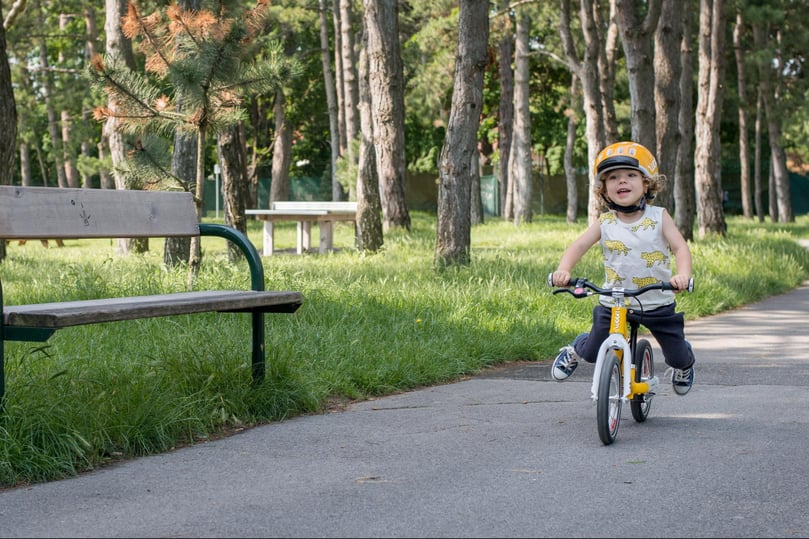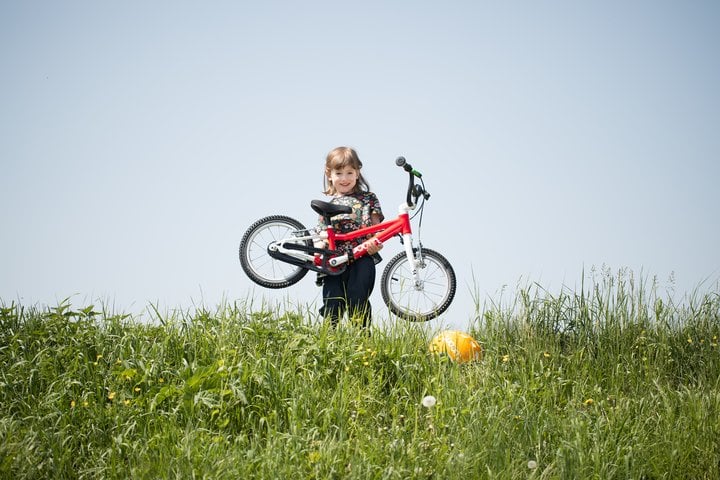There’s something truly magical about your child’s first few unsupported metres on a bike! In fact, it’s hard to know who is most proud – parents or child? Either way, the best thing about learning to ride is that once learned, never forgotten!
At the beginning of anyone’s two-wheeled journey, the fundamental aim is to instill the love for cycling into your child. Keep reading to find out how you can be proactive in helping your child’s development on a bike.
Let’s begin by covering a few basic pointers: As your child’s first cycling endeavors can often be characterized by worry or even fear of falling off, it’s crucial to create a safe and encouraging environment:
- Make sure they are riding a child-specific bike; not only does this guarantee safety and smiles, it also drastically improves the speed with which they’ll pick it up. Check out this article for what makes a good child-specific bike.

- Tumbles are inevitable. But a little crash every now and again should not result in injuries. For this reason: always wear a helmet! Double-check it is fitted correctly on your child's head. Cycling gloves and knee and elbow protectors are also sensible for added protection from bruises and scratches. They will also boost your child’s confidence.
- Pick a practice area that’s away from traffic and free of any potentially stress-inducing elements. Look for a courtyard, park or pedestrianized road. Avoid tarmac if possible; using a grassy area, lawn or patch of woodland will be less intimidating for the little crash pilot on their first few wobbly attempts.
- No stabilizers or training wheels, please! Just because rickety training wheels were once the norm for our generation, that does not mean they should be inflicted on our children. By riding with training wheels, your child is granted a false sense of security, which ultimately has a counterintuitive effect on how they develop their balance skills. Later down the line, the transition to a pedal bike will be more difficult as your child will have to re-learn how to balance. We therefore stand by our recommendation:
All hail balance bikes!

Thanks to balance bikes, learning to ride as a kid is so much easier these days! Why’s that, you ask? Because it’s just playing. By riding one of these miraculous inventions, kids are acquainted with the fundamentals of cycling in the most fun way imaginable and get a gentle introduction to just how good it feels to glide over the ground.
In their earliest attempts, your child will probably keep their feet on the ground or simply prop the balance bike between their legs and shuffle along. But once their confidence grows, they’ll begin to lift their feet off the ground more often as they train their sense of balance. Within no time at all, your child will be able to cover increasing distances, continuing to develop their balance skills and even brave some changes in direction. We highly recommend that their balance bike is equipped with child-specific rim brakes – this introduces them to hand-operated braking right from the start, which means one less skill to learn when they move up to a pedal bike :) Sturdy shoes are also important because their feet will probably be used for braking at the beginning. If you’re in any doubt about what type of brakes are best for kids, we have outlined the drawbacks of coaster brakes and explain our standpoint in this article.
On your pedals, ready, go!
Once they have mastered balance biking, the only thing left is the small matter of pedalling – a skill usually acquired in record time! But don’t worry; even if your child is not a balance bike graduate, this will not stop them from making a success of pedalling!. Here goes:
- Make time to show your child how pedaling works. Do this by lifting the rear wheel and turning the cranks. This shows your child how the cranks and wheels work together. Now show them what happens when you brake. We are guessing that by now, they will be very keen to have a go at pedaling.
- It’s totally normal that your child will be a little wound-up before their first attempt at riding. You can boost their confidence by gently resting your hands on their shoulders, or supporting the saddle as you run or walk alongside them. Once they pick up some speed, they’ll balance without realizing it!
- Now you are just moments away from the magic! Once they master the pedalling motion and how to keep balance, your support will no longer be needed – now is the time to raise your hands as your child rides on their own. Stay alongside them to help them stop safely, or to keep them upright and prevent a crash if they look as though they are at risk of toppling to one side.
- After a few tries, it’s time for them to brake independently. Encourage them to use the brake lever before putting their feet on the ground.

- Some children find it hard to push off freely from stationary. Try this approach: the dominant leg needs to be at 1’o clock when they’re ready to push off. From here, use that leg to push down on the pedal while raising their free leg off the ground at the same time. Alternatively, your child could try a rolling start – like on a balance bike – and simply raise their feet onto the pedals when they have reached a good speed. This is best practiced on a gentle downhill slope.
As the observing adult, it’s important for us to act casual at this early stage in their learning. Be patient and offer words of encouragement if needed – it might not always be straightforward. Make sure your expectations are not too high; regular short bursts of practice for a few minutes at a time will work. Being in an environment with lots of other kids on bikes could also provide additional motivation, with contagious enthusiasm and a high likelihood that your child will pick up some useful tips.
As time goes on, your child will feel more and more confident before they eventually yell with pride: “Look, I’m riding a bike!”
When is the right time for my child to learn how to ride a bike?
Young children are yet to fully develop their cognitive and motor processes. This includes skills that are fundamental to cycling – such as keeping balance, dexterity of hands and fingers, reaction times and sense of orientation. As such, the right moment depends less on a child’s age and more on a child’s current state of development. Some children won’t learn how to ride a bike until they start primary school, whereas others will cruise comfortably on a balance bike at the age of three or four – already in a fit state to transition to a pedal bike. If you try to rush the process with a child that lacks sufficient motor skills, there is a risk that it becomes too much like hard work, or – worse still – they develop a sense of fear or anxiety at the prospect of riding a bike. As this is something we’d like to avoid at all costs, the best thing is to continue having fun on the balance bike until your child is truly ready for the transition.
In general, the speed of your child’s learning should be dictated by their motivation and fueled by their inspiration for two wheels. Attempting to speed up this process through pressure could result in the opposite. By including your child in the family passion for bike rides from a very young age – whether in a child’s seat or bike trailer – means that they are highly likely to develop a genuine fascination for cycling, simply by being in the moment and surrounded by two wheels.
We are curious to hear your best tips for tyro bike riders! What worked for your offspring?


.jpg?width=926&upsize=true&name=woom_still_and_moving_in_action_2018_345-Edit-720x480-32ef3212-c95f-4d63-b83a-d57bf7c038f6%20(1).jpg)
